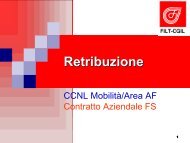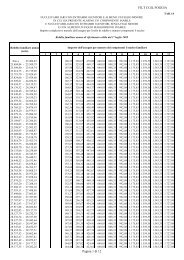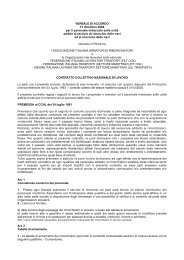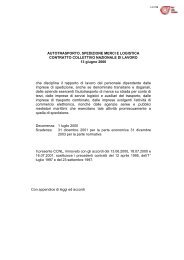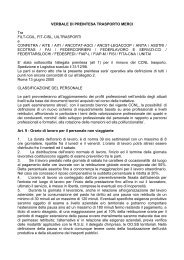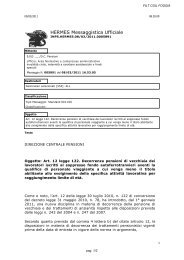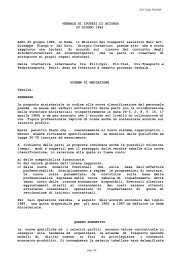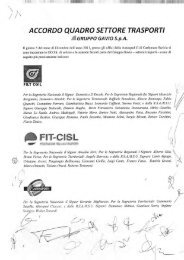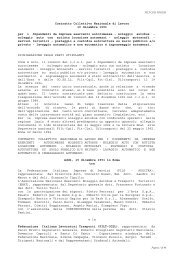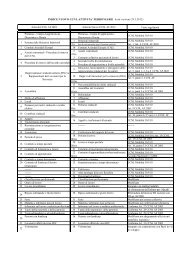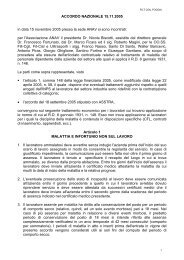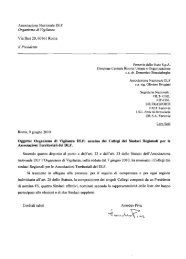Outlook for Air Transport to the Year 2025 - FILT CGIL Foggia
Outlook for Air Transport to the Year 2025 - FILT CGIL Foggia
Outlook for Air Transport to the Year 2025 - FILT CGIL Foggia
- No tags were found...
Create successful ePaper yourself
Turn your PDF publications into a flip-book with our unique Google optimized e-Paper software.
Chapter 2AIR TRANSPORT TRENDS AND CHALLENGESECONOMIC DEVELOPMENT AND AIRLINE TRAFFIC PATTERNS1. From a long-term his<strong>to</strong>rical perspective, air transport has experienced greater growth than most o<strong>the</strong>rindustries. Since 1960, increasing demand <strong>for</strong> passenger and freight services, rapid technological development andassociated investment have combined <strong>to</strong> multiply <strong>the</strong> output of <strong>the</strong> air transport industry by a fac<strong>to</strong>r of more than 30in terms of TKPs. This expansion of air transport compares favourably with <strong>the</strong> broadest available measure of worldoutput, <strong>the</strong> global GDP, which when measured in real terms has multiplied by more than 5 times over <strong>the</strong> sameperiod.2. Economic <strong>the</strong>ory and analytical studies indicate that <strong>the</strong>re is a high correlation between <strong>the</strong> growth patternsof air traffic and economic trends in that <strong>the</strong> demand <strong>for</strong> air transport is primarily driven by economic development.Changes in personal income affect <strong>the</strong> level of consumer purchasing power and <strong>the</strong> propensity <strong>to</strong> undertake leisuretravel. Commercial activity and trade have a direct impact on <strong>the</strong> demand <strong>for</strong> business travel and <strong>for</strong> air freight.Figure 2-1 provides evidence of <strong>the</strong> relationship between <strong>the</strong> strength of <strong>the</strong> economy and traffic demand byillustrating <strong>the</strong> fluctuations in <strong>the</strong> rate of growth of each <strong>for</strong> <strong>the</strong> period 1960 <strong>to</strong> 2005. The impact of economicslowdowns and recessions on air traffic trends is clearly visible during <strong>the</strong> following years or periods: 1974–75,1980–82, 1990–91, 1998 and 2001 (<strong>the</strong> latter coupled with <strong>the</strong> unprecedented events of 11 September).3. Between 1985 and 2005, worldwide scheduled traffic, measured in TKPs, grew at an average annual rateof 5.5 per cent, compared <strong>to</strong> a 3.7 per cent GDP growth. While <strong>the</strong> pattern of traffic growth over that period wasgenerally a reflection of economic conditions, <strong>the</strong> impact of recent event-related developments on air traveldemand (events of 11 September 2001, war in Iraq and <strong>the</strong> SARS outbreak) indicate that <strong>the</strong> air transport industryis sensitive <strong>to</strong> safety and security concerns which influence consumer confidence.4. O<strong>the</strong>r fac<strong>to</strong>rs that have affected traffic demand include airline costs, and hence fares and rates, regula<strong>to</strong>rydevelopments and <strong>the</strong> access <strong>to</strong> air and <strong>to</strong>urism services. Rapid growth in <strong>the</strong> 1960s coincided with <strong>the</strong>replacement of pis<strong>to</strong>n-engine aircraft with jet aircraft which led <strong>to</strong> reduced real fares and increased speed andcom<strong>for</strong>t of travel. In addition <strong>to</strong> an adverse effect on <strong>the</strong> world economy, sharp changes in <strong>the</strong> price of oil andaviation fuel (such as in 1973–1974 and fur<strong>the</strong>r escalation during 1979–1981) have had important effects onairline costs. Most recently airline costs have been negatively affected by increasing insurance and security costsin addition <strong>to</strong> <strong>the</strong> sharp hike in oil prices. More details are provided in paragraph 22.TRENDS IN SCHEDULED PASSENGER, FREIGHT AND MAIL TRAFFIC5. Over <strong>the</strong> decades, <strong>the</strong> growth experienced by <strong>the</strong> <strong>to</strong>tal demand <strong>for</strong> air transport has been shared <strong>to</strong> avarying extent by each of its major components — passenger, freight and mail traffic. The average growth rate <strong>for</strong>each of <strong>the</strong>se components has declined since <strong>the</strong> mid-1970s as shown in Table 2-1. The gradual decline in mailtraffic has been particularly severe, partly because of increasing competition from telecommunications.5




